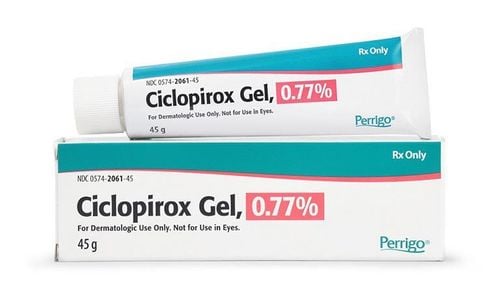This is an automatically translated article.
Cortimax is a prescription medication used in the treatment of a number of dermatological conditions. Complying with indications and doses of Cortimax will help patients improve treatment efficiency and ensure safety for health.
1. What are the effects of Cortimax?
Cortimax is a drug for the treatment of dermatological diseases, prepared in the form of a skin cream, with the main ingredients of the drug being:
Chloramphenicol; Triamcinolone . Chloramphenicol is an antibiotic, it is usually bacteriostatic, but can also be bactericidal at high concentrations or against highly susceptible strains.
Chloramphenicol inhibits protein synthesis in susceptible bacteria by binding to the 50S subunit of the ribosome. This active ingredient has the same site of action as other antibiotics such as Erythromycin, Lincomycin, Clindamycin, Oleandomycin and Troleandomycin.
Chloramphenicol can also inhibit protein synthesis in rapidly proliferating mammalian cells.
Chloramphenicol can cause bone marrow depression and may not be reversible. Chloramphenicol has immunosuppressive activity if administered systemically before antigenic stimulation. However, the antibody response may not be significantly affected when the drug is administered after exposure to the antigen.
Active ingredient Chloramphenicol has no effect on strains of Escherichia coli, Staphylococcus aureus, Shigella flexneri, Enterobacter spp., Salmonella typhi, Streptococcus pneumoniae and has little effect on fungi.
Triamcinolone is a fluorinated synthetic glucocorticoid. This active ingredient is often used as an alcohol or ester, orally, intramuscularly or topically, inhaled and applied topically to treat disorders requiring corticosteroids.
Triamcinolone has anti-inflammatory and allergic, immunosuppressive effects. Because this active substance has almost no effect of mineral-regulating corticosteroids, it should not be used alone to treat adrenal insufficiency.
The salt and water retention effects of Triamcinolone are weak, but the other effects of the drug are stronger and last longer than prednisolone. At high doses, systemic administration, triamcinolone has the effect of inhibiting the secretion of adrenocorticotropic hormone (ACTH) from the pituitary gland, causing secondary adrenal insufficiency, when the adrenal cortex stops secreting corticosteroids.
Cortimax is indicated in the following cases:
Allergic skin diseases such as Eczema, dermatitis,...; Trichophyton fungal diseases such as: tinea versicolor, tinea versicolor, tinea versicolor, tinea pedis, tinea pedis; Candidiasis of the skin.
2. Dosage and how to use Cortimax
After washing the diseased area, apply a thin layer of Cortimax medicine and then rub it gently in the affected skin area and spread it to the surrounding area; Use the drug 2 times a day, in the morning and evening, continuously until a month or at least 2 weeks after the symptoms are gone to prevent the disease from recurring; Avoid scratching the skin before applying Cortimax; It is necessary to keep the diseased skin area clean and dry, combined with personal hygiene as well as the living - working environment; Clinical symptoms usually improve within the first week of using Cortimax; Although the symptoms of the disease may have just eased, you should avoid stopping Cortimax midway, but should continue using the drug until the end of the course; If your symptoms do not improve after 4 weeks of using Cortimax, you need to review your diagnosis or change another drug; Stop using Cortimax immediately if the condition gets worse or irritation occurs; With skin lesions with many scales, secretions, pus or dirty fluid, you should clean before applying Cortimax and avoid dressing or covering.
3. Side effects of the drug Cortimax
During the use of Cortimax, you may encounter the following side effects:
Redness; A stinging sensation; Blisters ; Exfoliate; Edema; Itchy; Medal ; Burning sensation; Generalized skin irritation, especially when skin has open lesions. If the above symptoms are mild, there is no need to stop taking the drug. If the above symptoms are severe, you need to stop taking the medicine and notify your doctor or immediately go to the nearest medical facility for timely treatment.
4. Precautions when using Cortimax
Cortimax is for external use only. Avoid contact of Cortimax with eyes. If irritation or sensitivity occurs, you need to discontinue Cortimax treatment and replace it with another therapy. Pregnancy: In clinical studies, when using Clotrimazole vaginal for pregnant women during the second and third trimesters, no side effects were found. However, at present, there are still no adequate and complete studies on the use of the drug in pregnant women in the first 3 months, so only use it if clearly indicated by the doctor and avoid large-scale application. Lactation: It is not known whether Cortimax is excreted in human milk. Care should be taken when administering Cortimax to a nursing woman. The article has provided information about the uses, doses and precautions when using Cortimax. To ensure safety for your health and maximize the effectiveness of your treatment, you need to take Cortimax exactly as directed by your doctor, do not increase or decrease the dose or give prescriptions to others to use.
Please dial HOTLINE for more information or register for an appointment HERE. Download MyVinmec app to make appointments faster and to manage your bookings easily.













